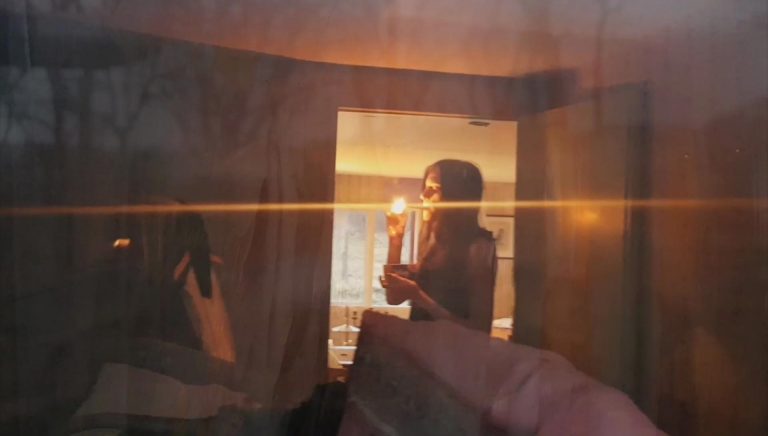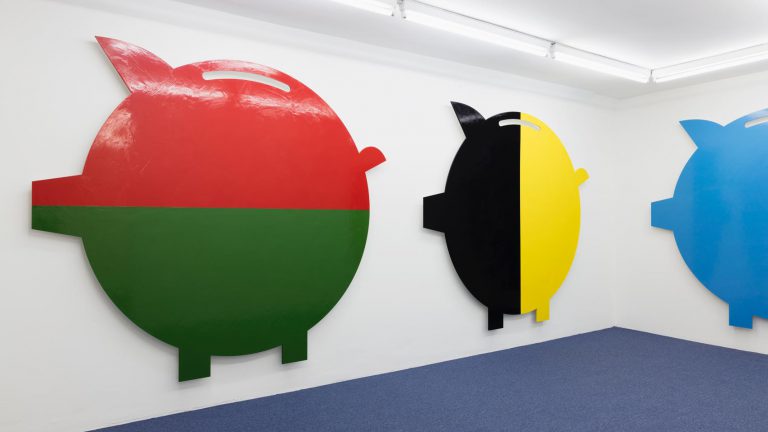Artist: Jan Kiefer
Exhibition title: Schwarz – Weiss
Venue: Union Pacific, London, UK
Date: March 15 – April 20, 2019
Photography: all images courtesy of the artist and Union Pacific, London
G: Our minds seem to like simple categorical ways to divide up information in the world – like Black and White, Up and Down, Yes and No, etc. This is kind of interesting given how complex and nuanced life is. Why do we so strongly tend towards categorical simplicity in understanding information?
J: It’s a common defense mechanism, no? The individual tends to think in extre-mes. It’s all good or all bad with no middle ground. It’s like a stair case the goes either Up or Down. There’s no other option.
K: Staircases do not contain many rules, and such rules are universally absolu-te. They go Up or Down, in order to facilitate movement from a higher or lower location to another with less effort. They represent one of the most ancient of technologies, a principal and ever-present architectural element. It has therefore become a symbol for the two opposite directions: Up and Down.
J: I took an image with my mobile last year. It shows the entrance of a high-rise slab block, exchangeable, modernist apartment building from the 1960s in Basel, Switzerland. At that time it was an ambitious promising architectural concept that was for whatever reason not developed further. The result is that there are just four of these buildings, standing a little bit lost next to each other. I pass them every day when I go to my studio. I’m pretty sure the flats in these buildings are nice, modern, and comfortable, but for sure, they are not very special—neither old nor modern, neither big nor small—just average. In the entrance of each building, next to the elevator a sign or site-specific artwork depicting simplified stairs shows the visitors where to find the staircase or the elevator. I’ve deve-loped a series of paintings based on these images. The stairs go either UP or DOWN, which means they are either a YES or a NO, depending on the viewer and the reading direction.
K: Yes and No, that reminds me of Joseph Beuys landmark audio work “JaJaJa-JaJaJaNeNeNeNeNe” (1967), in which he repeated the Yes and No phrase like a mantra in a monotonous, compulsive fashion. The one-hour audio performance means everything and nothing, while perhaps expressing the assertive ambiva-lences of everyday life.
S: In General, Jan in his series of paintings and sculptural arrangements addres-ses the myth of the achievements of a currently well to do middle class, that, caused by the on going redistribution of resources to the 1%, already faces social decline.
Viewed from the front the bottles in the wine shelves form a pattern of letters: JA, JA. The voice of Joseph Beuys soundlessly meanders through the sterile space of material wish fulfillment, ja, ja, ja, ja, ja, ne, ne, ne, ne, ne…. The ne, ne, nes are missing in Jan’s image. In a consumer culture informed by tautologisms, the opposite poles remain void. In Kiefer’s work one hears the No (ne) as an echo, in which the counter world still resonates.
J: I was using wine or grapes as a strong symbol for Western cultural traditions several times now. Wine is one of the oldest cultural heritages with a lot of refe-rences and of course a strong religious imagery as well.
K: I remember the still life paintings of the most universal Western symbol, the grape – a portrait of a Pinot Noir grape and a Pinot Blanc grape – Noir et Blanc, Black and White. The paintings are reminiscent of Zeuxis’ mythic painting of grapes, so realistic that the birds descended upon the surface to peck at the fruit. I’m thinking of Caravaggio as well and his paintings showing Bacchus or the young sick Bacchus. At the same time the paintings evoke mass-produced paintings of grapes typically shown at middle class dining establishments to sug-gest a sense of authenticity and refinement. In both cases there is a confusion of reality and image, of what is natural and “unnatural”.
J: Authenticity and reality make me think of an imaginary culture. The behaviour patterns resulting from a consumer society or the people‘s interaction with an in-doctrinated belief system all create visual codes and connotations of an imagina-ry culture. In turn, these visual codes become the very commodities that define a generation. But one can mirror these social patterns by deconstructing everyday objects and their associated mannerisms.
Jan Kiefer (*1979 in Trier, D, lives and works in Basel, CH) Since completing his master’s degree at the Academy of Arts and Design in Basel in 2012, Kiefer has exhibited widely, in Switzerland and internationally, including at Museum Haus Konstruktiv Zürich (CH), Nagel Draxler, Cologne (D), Glasgow international, Scotland (UK); Kai Matsumiya, New York (US); Kunstverein SALTS, Basel (CH); Union Pacific London (UK); Sculpture Park Cologne (D); White Co-lumns (NY); Kunsthalle Basel (CH); Kunsthaus Baselland (CH); Kunstverein Wie-sen (D); Kunsthalle Athena (GR); Kunsthalle Exnergasse Vienna (AUT); Gagosian Gallery (GR). a.o. He’s currently a lecturer at the Art Academy in Basel (CH). In 2016 he received the Swiss Art Award. He will be an Artist in Residence at the Swiss Institute New York (US) in 2019.
Jan Kiefer, Schwarz – Weiss, 2019, exhibition view, Union Pacific, London
Jan Kiefer, Schwarz – Weiss, 2019, exhibition view, Union Pacific, London
Jan Kiefer, Schwarz – Weiss, 2019, exhibition view, Union Pacific, London
Jan Kiefer, Schwarz – Weiss, 2019, exhibition view, Union Pacific, London
Jan Kiefer, Schwarz – Weiss, 2019, exhibition view, Union Pacific, London
Jan Kiefer, Schwarz – Weiss, 2019, exhibition view, Union Pacific, London
Jan Kiefer, Schwarz – Weiss, 2019, exhibition view, Union Pacific, London
Jan Kiefer, Schwarz – Weiss, 2019, exhibition view, Union Pacific, London
Jan Kiefer, Schwarz – Weiss, 2019, exhibition view, Union Pacific, London
Jan Kiefer, Schwarz – Weiss, 2019, exhibition view, Union Pacific, London
Jan Kiefer, Stairs – Orange, 2019, Acrylic and acrylic medium on canvas, 200 cm x 160 cm
Jan Kiefer, Stairs – Permanent Green, 2019, Acrylic and acrylic medium on canvas, 200 cm x 160 cm
Jan Kiefer, Stairs – Indian Yellow, 2019, Acrylic and acrylic medium on canvas, 200 cm x 160 cm
Jan Kiefer, Pinot Blanc, 2018, Oil on canvas, 50 cm x 40 cm
Jan Kiefer, JaJaJa – Univers Regular, 2018, Acrylic and acrylic medium on canvas, 160 x 120 cm
Jan Kiefer, NeinNeinNein – Franklin Gothic, 2018, Acrylic and acrylic medium on canvas, 160 x 120 cm
Jan Kiefer, JA JA wine racks, 2019, Pine and 23 wine bottles of Red Castellore Chianti DOCG and 23 bottles of White The Fire Tree Sicilian Fiano, 25cm x 146cm x 119cm
Jan Kiefer, JA JA wine racks, 2019, Pine and 23 wine bottles of Red Castellore Chianti DOCG and 23 bottles of White The Fire Tree Sicilian Fiano, 25cm x 146cm x 119cm
Jan Kiefer, Pinot Noir, 2018, Oil on canvas, 50 cm x 40 cm

























